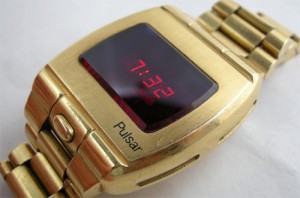The Worlds First LED Digital Watch
The first digital wrist watch was made by American timepiece manufacturer Hamilton Watch Company in 1972.
The Pulsar wrist watch, was made of 18-carat gold, costing $2,100. Time was shown by pressing a button on the side of the device, after which an LED showed a glowing red display of the time in digital numbers.
In their article “History of the Digital Watch,” the BBC notes that Hamilton Watch Company also designed a digital clock prior to this in 1968, which appeared in the movie “2001: A Space Odyssey,” made by Stanley Kubrick. This clock was meant to give a hint to viewers of the coming revolutionary digital timepieces and spark curiosity. The digital watch was especially popular; by 1975, more than 80 types were on the market, giving its analog competitor a detrimental blow.
By the early 1980s, the BBC notes that Japan began concentration on further development of digital timepieces.
Digital watches could display the time and date by this time – also stopwatch features were becoming popular.
Smaller digital alarm clocks became common.
Powered by electricity, they were usually reliable except for one problem: when the power went out, even for a second, the clocks would reset themselves. Clocks with a backup battery source were later introduced on the market.
According to Wikipedia, digital clocks became standard in automobiles during the 1980s. Before this time, the standard was a circular or square-shaped analog clock with unnumbered markings indicating the 12 points on a traditional clock face. Digital display clocks today are far more advanced, with more elaborate models able to display temperature, the date and more defined fragments of time. Some special types of clocks, such as Atomic Clocks, also commonly use digital displays.
Many early clock patents describe a Geneva gear mechanism, which is described as a turning wheel with leaf plates used to display the time. The wheel was powered by a crystal oscillator. One downfall of the Geneva gear was that it could only have a ratio of 12 to 1; the leaves could not be segmented into 1 and 10-minute intervals. This would require 60 leaves to be put on a wheel, which would be impossible for the small compact clock design that was desired for digital clocks.





